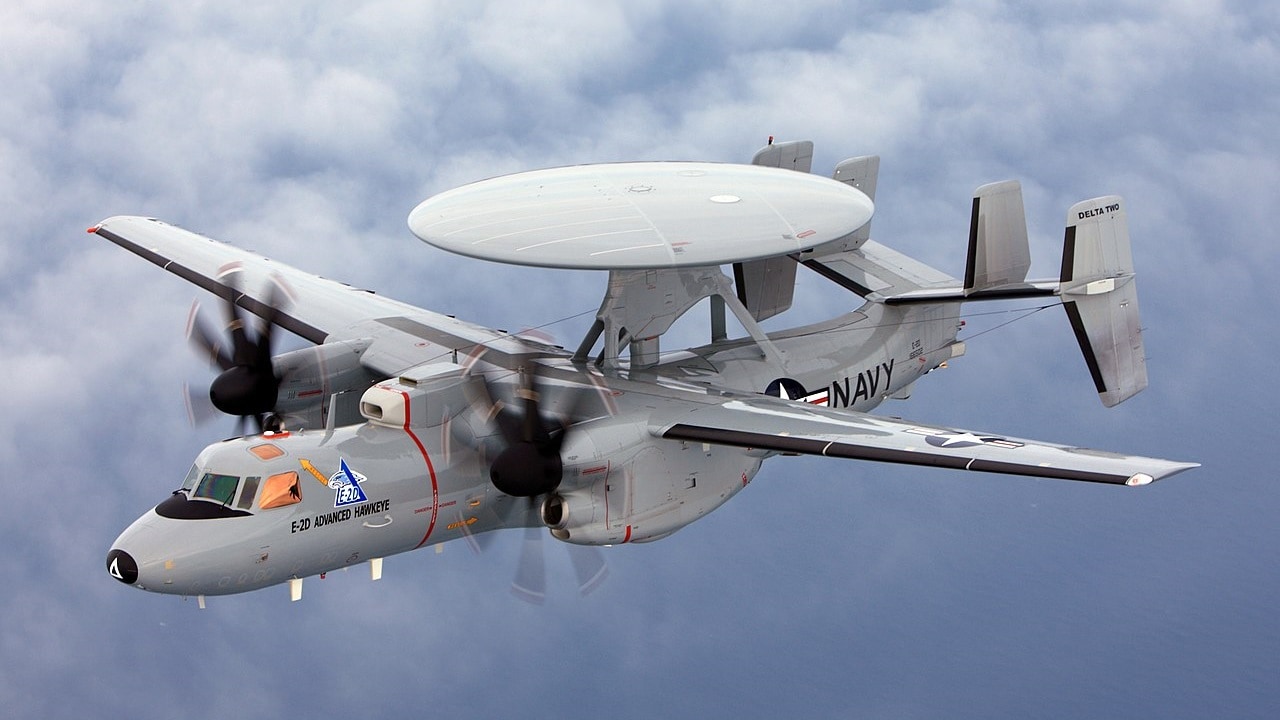The E-2 Hawkeye, Explained: Still in service after sixty years, the Northrop Grumman E-2 Hawkeye is an all-weather, carrier-capable tactical airborne early warning (AEW) aircraft. Designed in the 1950s, the E-2 first flew in 1960 before entering service in 1964. The E-2 has been in production, in one variant or another, continuously since 1960 – giving the E-2 the longest production run of any carrier-based aircraft ever.
Built to replace the E-1 Tracer, the E-2 was the first aircraft of its kind ever crafted specifically for airborne early warning (earlier AEW planes were just modified from existing airframes). The E-2, which uses twin turbo-prop engines, has earned the nickname “Hummer,” due to the distinct humming sound the prop engines make – which is easily discernible from the roar of a carrier’s jet engine fleet.
When designing the Hawkeye, Northrop Grumman faced a series of challenges. First, the US Navy required that their new AEW plane could integrate its data with the Naval Tactical Data System found aboard Navy vessels. Second, the E-2 needed to land on aircraft carriers, which in the late 1950s meant some modern carriers – as well as some older World War II era carriers, the Essex-class, specifically. The Essex was built during the Second World War but remained in service after the fall of Japan, having been modified to allow for jet aircraft operation. Still, the Essex was small, so the E-2 designers worked with constraining height, weight, and length restrictions – which resulted in undesirable handling characteristics. Despite the hassle, the E-2 never operated from the Essex-class carriers.
The E-2 is a high-wing aircraft with two Allison T56 turboprop engines. Using a retractable tricycle landing gear and tail hook, the E-2 can launch from and land on modern aircraft carriers. The E-2 is visually distinct for its 24-foot diameter rotating radar dome (rotodome). The rotodome houses the E-2’s long-range radar and IFF systems. The E-2 is the only carrier-based airplane with a rotodome; all other rotodome-carrying aircraft, like the E-3 Sentry, are land-based.
Like many carrier-based aircraft, the E-2 features folding wings, the Sto-Wing, for the space-saving that is so valuable aboard an aircraft carrier. The AEW plane requires a crew of five: a pilot and co-pilot sitting in the flight deck, plus a combat information center officer, air control officer, and radar operator sitting at stations in the fuselage, below the rotodome.
Entering service in 1964, the E-2 experienced considerable problems. Namely, inadequate cooling was causing the closely packing avionics equipment to overheat. The systems became so unreliable that the entire E-2 fleet was grounded while the problem was corrected. Computer and equipment upgrades were made, resulting in an E-2B variant with improved reliability. The E-2 gradually proved itself, becoming a vital component of the US Navy carrier air wing – today, each carrier air wing features four E-2s.
Upgrades have been made throughout the E-2’s service life, through the B-variant and then the C-variant. Today, the E-2D, or Advanced Hawkeye, operates. The E-2D is fully upgraded to meet the needs of a modern Navy. With AN/APY 9 radar, T-56-A-427A engines, a glass cockpit, and the capacity for aerial refueling, the E-2D is a modernized warfighter.
In addition to serving with the US Navy, the E-2 has been exported to allies around the world. Japan, Mexico, France, Egypt, and Taiwan all currently operate the E-2.
Harrison Kass is the Senior Defense Editor at 19FortyFive. An attorney, pilot, guitarist, and minor pro hockey player, he joined the US Air Force as a Pilot Trainee but was medically discharged. Harrison has degrees from Lake Forest College, the University of Oregon, and New York University. He lives in Oregon and listens to Dokken. Follow him on Twitter @harrison_kass.

